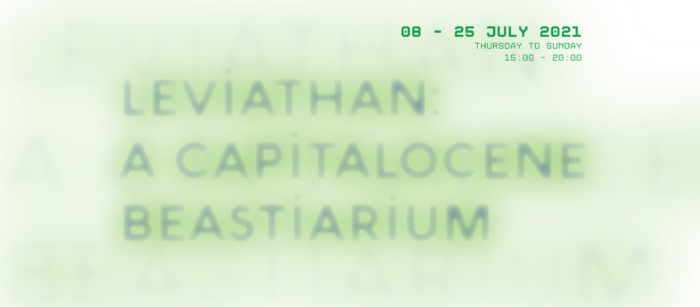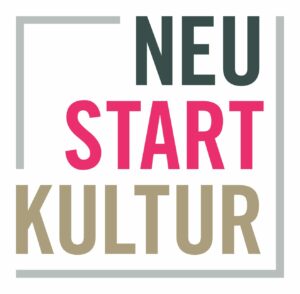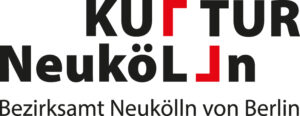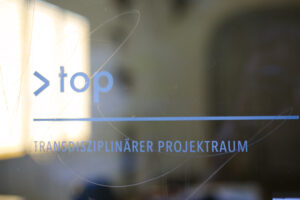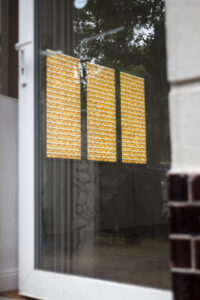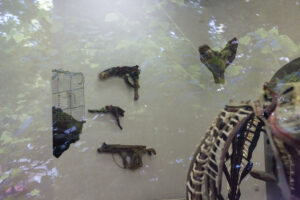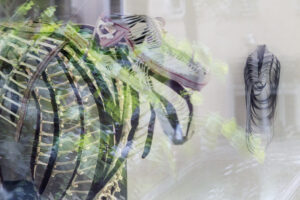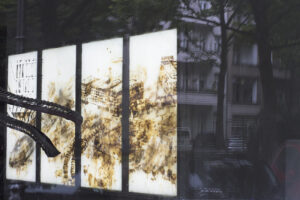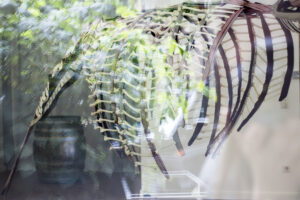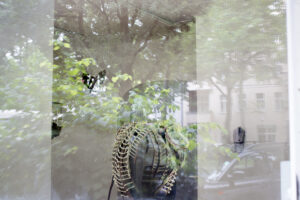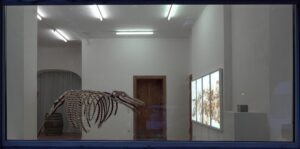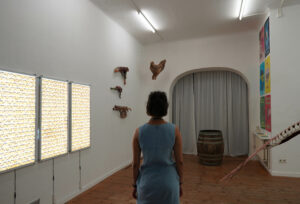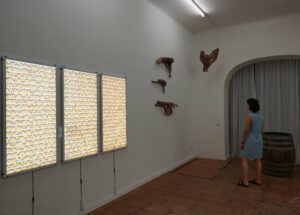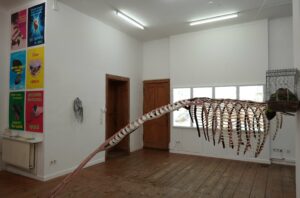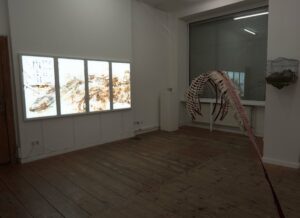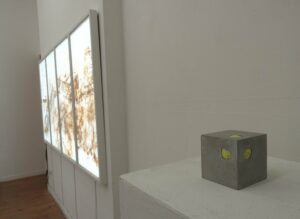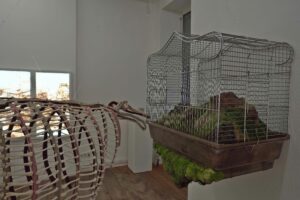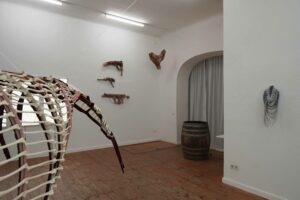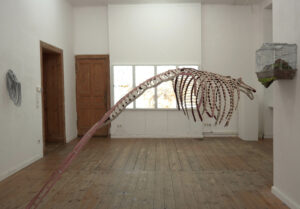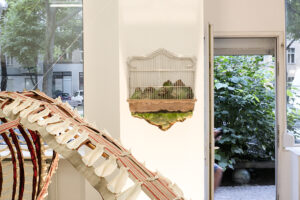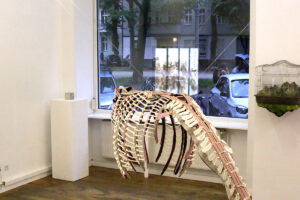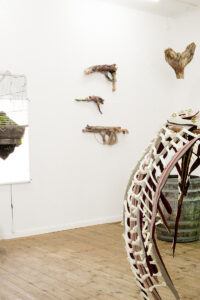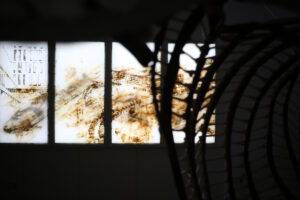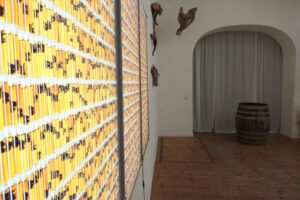Exhibition
08 – 25 July 2021 | Thursday to Sunday, 15:00–20:00
Public Program on July 11th, 18th and 23rd.
Artists: Yoav Admoni, Lisa Glauer, Tea Mäkkipää, Sybille Neumeyer, Jaanika Peerna, Moran Sanderovich, Kaethe Wenzel, Michael John Whelan.
Conceptualization and Co-curation: Tuçe Erel, Lisa Glauer, and Kaethe Wenzel
(Deutsche version weiter unten.)
Leviathan: A Capitalocene Beastiarium is a research-based exhibition project, which unpacks “human nature” and “law of nature”, inspired by Thomas Hobbes book Leviathan (1651) [1] and Capitalocene, a concept coined by Jason W. Moore and Donna Haraway.
Hobbes’ Leviathan is recognized as one of the first texts to criticize existing power relationships, problems of collective violence and the instrumentalization of religion for the implementation of a class hierarchy. Leviathan represents capitalism’s giant systems, hierarchies, and infrastructures designed to mandate, oppress, and manage human and non-human beings and finally reinforce the anthropocentric position of humankind. Hobbes discussed the power of human masses, or collectives, and the constant aggression of humans against each other, which seems to describe the Capitalocene era. On the edge of the sixth mass extinction, ecological crisis, and the alienation of humans from the non-human world, Leviathan is still standing. It continues to expand – enlarging and invading the mind, society, politics, and natureculture. Leviathan is everywhere, we cannot see it, but we feel its breath at the back of our necks.
The exhibition criticizes the structures of capitalism and patriarchy in relation to Hobbes’ Leviathan and Capitalocene concept, which Moore and Haraway proposed against the Anthropocene era. The invited works are pointing to the destruction of the Earth’s ecologies through such systems. Positioning Kaethe Wenzel’s Leviathan (2020), the exhibition discusses these systems and their impact on social, economic, and ecological spheres.
[1] Thomas Hobbes, Leviathan, ed. J. C. A. Gaskin (Oxford: Oxford University Press, 1651).
Hygiene Concept: TOP abides by the hygiene regulations set by the Berlin Senate. The maximum number of visitors at the same time is limited to 5 people. Visitors must wear a medical face mask (FFP2) during their visit. All visitors must have a current negative Corona test (within 24 hours), complete proof of vaccination or proof of recovery to attend the events.
When it is necessary, the hygiene concept will be updated on TOP e.V. website.
Public Program
The public events on 11.07 and 18 .07 feature curatorial talk, artists’ talks, lectures, and performances will take place at Tempelhofer Feld, located 5 minutes walking distance from the exhibition space, TOP Transdisciplinary Project Space. The closing event will be an online lecture and virtual exhibition tour on 23.07. Click here for the exact location at Tempelhofer Feld.
11.07
13:30 Welcoming & curatorial talk: Kaethe Wenzel, Lisa Glauer, Tuce Erel
14:00 Kaethe Wenzel, artist talk and interactive performance with mechanic Bone-bots
16:00 Artist Talk: Tea Mäkkipää & Sybille Neumeyer
18:00 Jaanika Peerna, Glacier Elegy Berlin, performance at Tempelhofer Feld.
18.07
15:30 Welcoming
16:00 Artist Talk: Moran Sanderovich und Lisa Glauer
18:00 Yoav Admoni, The invention of nature, Lecture Performance at Tempelhofer Feld
Hygiene plan for Leviathan Public Program: Participants of the public program must agree to share their full names, telephone numbers, and addresses or e-mail addresses. Contact details and the district or municipality of residence of all participants are recorded. This information will be collected via Luca App and kept encrypted. In the event of infection, the health department can use the list to quickly notify all potential contacts. (Paper-based contact collection will be provided as well) The data must be kept for four weeks and then destroyed. All visitors must have a current negative Corona test (within 24 hours), complete proof of vaccination, or proof of recovery to attend the events.
23.07 / Online closing talk / live-stream via Youtube 18:00 – 19:30
18:00 – 18:30 – Welcoming and virtual exhibition tour.
18:30 – 19:00 The lecture of Dr. Olga Smith (University of Vienna) is titled Sublime in the Anthropocene.
19:00 – 19:30 Discussion and Q&A
Abstract Sublime in the Anthropocene: In Hobbes’s political analogy, Leviathan overcomes the wolf-man, who symbolically represents the untamed state of nature. This lecture proposes to re-examine the hierarchical relationship established in this parable, by taking account of the epistemological challenges to the notion of nature and humankind posed by the emergence of the concept of Anthropocene. I propose to do this through the aesthetic category of sublime to designate a human-nature relationship predicated on renewed appreciation of nature as uncontrollable and potentially dangerous power.
The exhibition and public program is kindly supported by NEUSTART KULTUR and Fachbereich Kultur von Neukölln.
DEUTSCH
Leviathan: Ein Bestiarium für das Kapitalozän
Künstler*innen: Yoav Admoni, Lisa Glauer, Tea Mäkkipää, Sybille Neumeyer, Jaanika Peerna, Moran Sanderovich, Kaethe Wenzel, Michael John Whelan.
konzipiert und kuratiert von: Tuçe Erel, Lisa Glauer, and Kaethe Wenzel
Veranstaltungsort: TOP Transdisciplinary Project Space (Schillerpromenade 4, 12049, Berlin)
Eröffnung: 08. Juli 2021, 15:00-21:30
Dauer und Öffnungszeiten: 08. – 25. Juli 2021 | Thursday to Sunday, 15:00 – 20:00
Veranstaltungsprogramm am 11., 18. Und 23. Juli.
Das Ausstellungsprojekt Leviathan: Ein Bestiarium für das Kapitalozän konfrontiert Begriffe wie “menschliche Natur” und “Naturgesetz”, nach Thomas Hobbes‘ Leviathan (1651)1, und das Konzept des „Kapitalozän“ nach Jason W. Moore und Donna Haraway.
Hobbes’ Leviathan gilt als der erste Text, der herrschende Machtsysteme in Frage stellt, und der die Probleme kollektiver Gewalt und die Instrumentalisierung der Religion, um ein hierarchisches Klassen-system zu etablieren.
Heute repräsentiert er die gigantischen Systeme des Kapitalismus: Hierarchien und Infrastrukturen, die darauf zugeschnitten sind, menschliche und nichtmenschliche Wesen zu verwalten, zu steuern und zu unterdrücken – und letztlich die anthropozentrische Haltung der Menschheit zu forcieren. Hobbes diskutiert die Macht von Massen und Kollektiven, und die konstante zwischenmenschliche Aggression, die charakteristisch für das Kapitalozän scheinen.
An der Schwelle des 6. Artensterbens, angesichts von Klimawandel und der Entfremdung der menschlichen von der nicht-menschlichen Welt, ist Leviathans Macht ungebrochen und er dehnt sich weiter aus – ergreift Besitz von Gedanken, Gesellschaft, Politik und NatureCulture. Leviathan ist überall – unsichtbar, aber wir spüren seinen Atem im Nacken.
Die Ausstellung kritisiert kapitalistische und patriarchale Strukturen im licht von Hobbes‘ Leviathan und dem begriff des „Kapitalozän“, den Harway und Moore als Gegenentwurf zum Anthropozän entwickelt haben. Die versammelten Arbeiten thematisieren die zerstörerische Wirkung dieser Strukturen auf die Ökosysteme der Erde. Mit Käthe Wenzels Leviathan (2020) im Zentrum, diskutiert die Ausstellung ihre sozialen, ökonomischen und ökologischen Auswirkungen.
Ausstellung und Veranstaltungsprogramm werden ermöglicht durch NEUSTART KULTUR und Fachbereich Kultur von Neukölln.
Hygiene Konzept: TOP folgt den Hygienebestimmungen des Berliner Senats. Zugelassen sind maximal 5 Besucher*innen auf einmal. Besucher*innen sollen FFP2 maske antragen. Alle Besucher+innen müssen einen negativen Corona-Test (nicht älter als 24 Stunden) bzw. Belege über volle Impfung oder Genesung vorlegen. Das Hygiene-Konzept wird gegebenenfalls auf der Webseite von TOP e.V. upgedated.
1 Thomas Hobbes, Leviathan, ed. J. C. A. Gaskin (Oxford: Oxford University Press, 1651).
Veranstaltungsprogramm
Die Veranstaltungen am 11.07 und 18 .07 umfassen Kuratorinnen-Gespräche, Artist Talks, Vorträge und Performances draußen vor den Räumen von TOP Transdisciplinary Project Space auf der Schillerpromenade und auf dem Tempelhofer Feld, 5 Gehminuten entfernt. Die Abschlussveranstaltung findet an Online Lecture und virtueller Ausstellungs-Rundgang am 23.07. statt. Der genaue Veranstaltungensort ist hier.Der genaue Veranstaltungensort ist hier.
11.07
13:30 Begrüßung & Kuratorinnen-Gespräch: Käthe Wenzel, Lisa Glauer, Tuce Erel
14:00 Käthe Wenzel, Artist Talk und interaktive Knochen-Roboter Performance
16:00 Artist Talk: Tea Mäkkipää & Sybille Neumeyer
18:00 Jaanika Peerna, Glacier Elegy Berlin, Performance auf dem Tempelhofer Feld.
18.07
15:30 Begrüßung
16:00 Artist Talk: Moran Sanderovich und Lisa Glauer
18:00 Yoav Admoni, The invention of nature, Lecture Performance, Tempelhofer Feld
Hygieneplan für das Leviathan Veranstaltungs-Programm: Die Teilnehmer*innen des öffentlichen Programms müssen sich damit einverstanden erklären, ihre vollständigen Namen, Telefonnummern und Adressen bzw. E-Mail-Adressen mitzuteilen (Die Anmeldung in Papierform wird bereitgestellt). Die Kontakt-Details und der Meldeort aller Teilnehmer*innen werden vorübergehend gespeichert. Im Fall einer Infektion kann das Gesundheitsamt anhand dieser Liste alle Teilnehmer*innen schnell benachrichtigen. Die Daten werden für vier Wochen gespeichert und dann gelöscht. Alle Besucher+innen müssen einen negativen Corona-Test (nicht älter als 24 Stunden) bzw. Belege über volle Impfung oder Genesung vorlegen.
23.07 / Online-Abschluss / Livestream via Youtube 18:00 – 19:30
18:00 – 18:30 – Begrüßung und virtueller Ausstellungs-Rundgang.
18:30 – 19:00 Vortrag von Dr. Olga Smith (Universität wien): Sublime in the Anthropocene.
19:00 – 19:30 Diskussion
Abstract: Sublime in the Anthropocene: In Hobbes’ politischer Analogie unterwirft Leviathan den Wolfsmenschen, der einen ungezähmten Naturzustand symbolisiert. Der Vortrag untersucht die hierarchischen Beziehungen, die in dieser Parabel etabliert werden, im Licht der epistemologischen Herausforderungen solcher Begriffe wie Natur und Menschheitwie sie sich im Rahmen des Anthropozän stellen. Durch die Linse der ästhetischen Kategorie des Sublimen werfe ich einen Blick auf die Beziehung von Mensch und Natur und die erneute Wertschätzung der Natur als einer unkontrollierbaren und potenziell gefährlichen Macht.
Video Documentation of Jaanika Peerna’s performance, Glacier Elegy Berlin (July 11, 2021) at Tempelhofer Feld
Photo-Documentation / Foto-Dokumentation
by Reelika Ramot and Tuçe Erel
TOP Transdisciplinary Project Space, Leviathan, 2021, Photo Credit: Reelika Ramot
TOP Transdisciplinary Project Space, Leviathan: A Capitalocene Beastiarium, 2021. (Neumeyer)
Photo Credit: Reelika Ramot
TOP Transdisciplinary Project Space, Leviathan: A Capitalocene Beastiarium, 2021, view from the outside (Admoni, Sanderovich, Wenzel)
Photo Credit: Reelika Ramot
TOP Transdisciplinary Project Space, Leviathan: A Capitalocene Beastiarium, 2021, view from the outside (Wenzel, Peerna)
Photo Credit: Reelika Ramot
TOP Transdisciplinary Project Space, Leviathan: A Capitalocene Beastiarium, 2021, view from the outside (Wenzel, Glauer)
Photo Credit: Reelika Ramot
TOP Transdisciplinary Project Space, Leviathan: A Capitalocene Beastiarium, 2021, view from the outside (Mäkkipää, Wenzel)
Photo Credit: Reelika Ramot
TOP Transdisciplinary Project Space, Leviathan: A Capitalocene Beastiarium, 2021, view from the outside (Admoni, Sanderovich, Wenzel, Peerna)
Photo Credit: Reelika Ramot
TOP Transdisciplinary Project Space, Leviathan: A Capitalocene Beastiarium, 2021, view from the outside (Mäkkipää, Wenzel, Glauer, Whelan)
Photo Credit: Tuçe Erel
TOP Transdisciplinary Project Space, Leviathan: A Capitalocene Beastiarium, group exhibition view, 2021. (Neumeyer, Sanderovich, Mäkkipää)
Photo Credit: Tuçe Erel
TOP Transdisciplinary Project Space, Leviathan: A Capitalocene Beastiarium, group exhibition view, 2021. (Neumeyer, Sanderovich, Mäkkipää)
Photo Credit: Tuçe Erel
TOP Transdisciplinary Project Space, Leviathan: A Capitalocene Beastiarium, group exhibition view, 2021. (Mäkkipää, Peerna, Glauer, Wenzel, Admoni)
Photo Credit: Tuçe Erel
TOP Transdisciplinary Project Space, Leviathan: A Capitalocene Beastiarium, group exhibition view, 2021. (Glauer, Whelan, Wenzel, Admoni)
Photo Credit: Tuçe Erel
TOP Transdisciplinary Project Space, Leviathan: A Capitalocene Beastiarium, group exhibition view, 2021. (Glauer, Whelan)
Photo Credit: Tuçe Erel
TOP Transdisciplinary Project Space, Leviathan: A Capitalocene Beastiarium, group exhibition view, 2021. (Glauer, Wenzel, Admoni)
Photo Credit: Tuçe Erel
TOP Transdisciplinary Project Space, Leviathan: A Capitalocene Beastiarium, group exhibition view, 2021. (Wenzel, Sanderovich, Mäkkipää, Peerna)
Photo Credit: Tuçe Erel
TOP Transdisciplinary Project Space, Leviathan: A Capitalocene Beastiarium, group exhibition view, 2021. (Peerna, Glauer, Wenzel, Admoni)
Photo Credit: Tuçe Erel
TOP Transdisciplinary Project Space, Leviathan: A Capitalocene Beastiarium, group exhibition view, 2021. (Wenzel, Admoni)
Photo Credit: Tuçe Erel
TOP Transdisciplinary Project Space, Leviathan: A Capitalocene Beastiarium, group exhibition view, 2021. (Whelan, Wenzel, Admoni)
Photo Credit: Tuçe Erel
TOP Transdisciplinary Project Space, Leviathan: A Capitalocene Beastiarium, group exhibition view, 2021. (Admoni, Sanderovich, Wenzel, Mäkkipää)
Photo Credit: Tuçe Erel
TOP Transdisciplinary Project Space, Leviathan: A Capitalocene Beastiarium, group exhibition view, 2021. (Glauer, Wenzel)
Photo Credit: Reelika Ramot
TOP Transdisciplinary Project Space, Leviathan: A Capitalocene Beastiarium, group exhibition view, 2021. (Whelan)
Photo Credit: Reelika Ramot
TOP Transdisciplinary Project Space, Leviathan: A Capitalocene Beastiarium, group exhibition view, 2021. (Neumeyer, Sanderovich, Mäkkipää)
Photo Credit: Tuçe Erel
Artworks:
Yoav Admoni, LandEscape 1 Fresh essays on Nature, 2020, Mixed media, 40x60x30cm.
Yoav Admoni’s sculpture LandEscape 1 displays a piece of uprooted earth inside a cage, hanging above the eye level to preserve what we have for now but may not have for long either. Admoni’s work engages with nature and its relation to the human body through sculpture, scenography, performance and public art. During the public program, Admoni performed a lecture about his current research on the history of botanic gardens on July 18th, 2021 at Tempelhofer Feld. Admoni’s focal point for the lecture is the English Landscape garden, a garden style, which emerged in England in the early 18th century, and spread across Europe. The English garden presented an idealized view of nature; it originated as a revolt against the architectural garden and drew inspiration from paintings of landscapes. What do we hear when we say the invention of nature? Aren’t we used to thinking of nature as the only thing that is constant, immanent, and permanent? The only thing that we are not the maker of?
Lisa Glauer, Skyjacking Across Borders with Toy Guns, 2017, Human milk on paper, ironed. 4 light boxes, 120×60 cm (each).
Lisa Glauer’s Skyjacking Across Borders with Toy Guns is part of the series of human-milk drawings, which criticizes and explores the contamination of human and nonhuman milk through human-made pollution of natural resources. Additionally, Glauer’s artistic research unpacks the power politics over borders and biopolitics, especially the hegemonic power over the female body. She is using human milk in her paintings to display the horrific scenes in the border cities such as Tijuana/San-Diego, where Glauer did research in depth in the last years.
Tea Mäkkipää, Fundamentalist, 2017, script & recitation by Joseph Porter, Sound installation, Wine barrel, speakers, dimensions variable.
Tea Mäkkipää, Battle of Australia, 2014, Designs for posters and other promotional articles celebrating endangered Australian animals.
Tea Mäkkipää will present a sound installation titled Fundamentalist, which tells a story of a man who tried to conquer the world with his offspring that also refers to the myths of Genghis Khan and Diogenes of Sinope. Additionally, Mäkkipää’s poster series titled Battle of Australia will be part of the exhibition. This project addresses the sixth mass extinction and reminds that many species are gone before they are named by scientists. The Battle of Australia project is an open source offering the designs for free for any organization/person who is committed to the work of saving these or other Australian species and wishes to sell merchandise of any sort and use the profits for saving their natural habitats or otherwise the well-being of those animals.
Sybille Neumeyer, Song for the Last Queen, 2012-13, Installation, bees, honey, 120×120 cm.
Sybille Neumeyer’s installation Song for the last Queen is a triptych displaying honey bees conserved in small glass tubes filled with honey. The work results from research and collaboration with beekeepers in the USA, Japan, and Germany, all facing colony collapse disorder. The causes of the loss of bee colonies are still unknown, but most likely linked to a combination of multiple stresses for the insects. Exposure to pesticides, pathogens and habitat loss amongst other anthropogenic impacts. This phenomenon is not only an economic issue in the agricultural sector, but also threatens the health of ecosystems and humans. The conserving properties of the honey here contrast the fragility of ecosystems. The work assembles a notation or score echoing the silencing of nature.
Jaanika Peerna, Droplines, 2021, dimensions variable.
Jaanika Peerna, Glacier Elegy Berlin, 2020-2021, performance, ca. 40 minutes.
Jaanika Peerna’s artistic practices are drawing and performance. Her performative language includes collaboration and audience engagement. The loss of glacial ice caused by climate change is at the core of her performances. In her performative drawing process, she thinks and senses with her entire body. Peerna is interested in the flexible nature of her drawings which she at times cuts methodically and sculpts into 3D paper objects, which end up looking like abstract sea creatures or the surface of the ocean. Besides exhibiting her wall installation, Jaanika Peerna performed a participatory work Glacier Elegy Berlin, where the central element is the last piece of natural ice left on Earth. Her performance took place in the public space at Tempelhofer Feld, near the exhibition venue during the public program on July 11th, 2021.
#GlacierElegy
Moran Sanderovich, Anthropobeast, 2015, silicone, bone, wood, and found objects, dimensions variable.
Moran Sanderovich shows triptych work titled Anthropobeast together with an untitled sculpture which connects her work with Wenzel’s works. Sanderovich engages with concepts like grotesque and uncanniness of human and non-human agency through visceral narratives, transformation and potentiality of agency. Her work challenges and confuses normative conceptions of bodily limitation, taking disability, mutation, and decay as starting points for other forms of life. She is also inspired by mythological worlds, tales of conflict, and Survival – themes and concerns which also drive the exhibition.
Kaethe Wenzel, Leviathan, 2019, various animal bones (roadkill), canvas, silk, thread, buttons, copper, tubes, brass/steel fastenings, dimensions variable.
Kaethe Wenzel’s work, the centerpiece of the exhibition, is titled Leviathan. It references Hobbes, mythology, mass extinction, and biopolitics. Wenzel’s Leviathan is part of the Bone Costumes series, which originated from her research into historical corsets – designed to press natural bodies into ideal shapes, much like sculpting tools. Leviathan is a whale-shaped imaginary animal skeleton, hanging from the ceiling, manifesting a critique to the canon of museology, scientific research systems and their display methodologies, as well as the alienation of non-human agencies from human perception.
Michael John Whelan, Inclusions (tennis ball), 2020, cast concrete cube containing a tennis ball retrieved 29/9/20, 10 x 10 x 10cm.
Michael John Whelan’s work Inclusions (tennis ball) is part of an ongoing project, in which items of plastic are removed from different seas across the world. These objects are cast into concrete, creating simple geometric forms. Inclusion (tennis ball) is a human-made conglomerate object, acts as an azoic monument to our destructive tendencies, and complicity in environmental degradation. It shows another face of the Capitalocene era that the exhibition explores.

